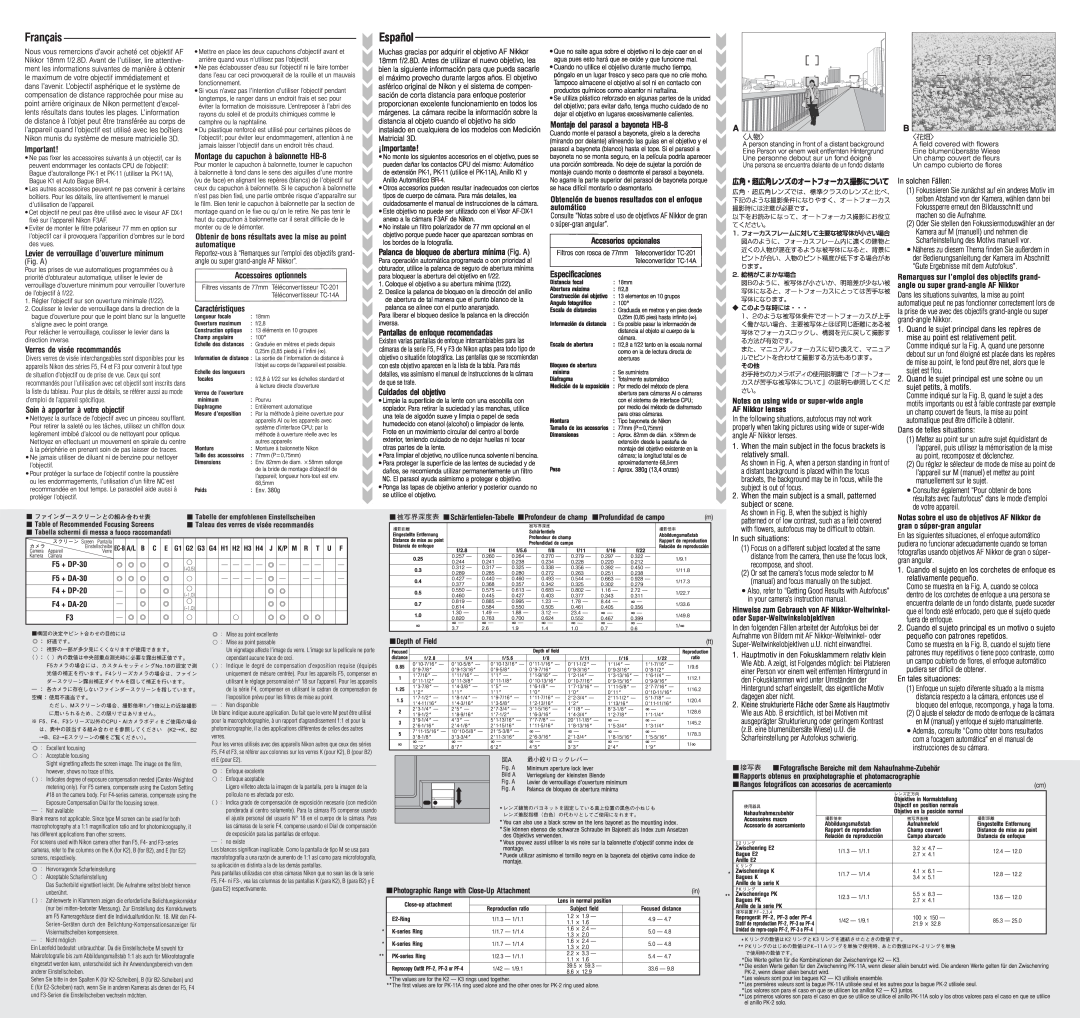
A |
〈人物〉
A person standing in front of a distant background Eine Person vor einem weit entfernten Hintergrund Une personne debout sur un fond éoigné Una persona se encuentra delante de un fondo distante
![]() 広角・超広角レンズのオートフォーカス撮影について
広角・超広角レンズのオートフォーカス撮影について
広角・超広角レンズでは、標準クラスのレンズと比べ、 下記のような撮影条件になりやすく、オートフォーカス 撮影時には注意が必要です。
以下をお読みになって、オートフォーカス撮影にお役立 てください。
1.フォーカスフレームに対して主要な被写体が小さい場合 図Aのように、フォーカスフレーム内に遠くの建物と 近くの人物が混在するような被写体になると、背景に ピントが合い、人物のピント精度が低下する場合があ ります。
2.絵柄がこまかな場合
図Bのように、被写体が小さいか、明暗差が少ない被
写体になると、オートフォーカスにとっては苦手な被 写体になります。
◆ このような時には・・・
1、2のような被写体条件でオートフォーカスが上手 く働かない場合、主要被写体とほぼ同じ距離にある被 写体でフォーカスロックし、構図を元に戻して撮影す る方法が有効です。
また、マニュアルフォーカスに切り換えて、マニュア ルでピントを合わせて撮影する方法もあります。
その他
お手持ちのカメラボディの使用説明書で「オートフォー カスが苦手な被写体について」の説明も参照してくだ さい。
Notes on using wide or super-wide angle
AF Nikkor lenses
In the following situations, autofocus may not work properly when taking pictures using wide or
1.When the main subject in the focus brackets is relatively small.
As shown in Fig. A, when a person standing in front of a distant background is placed within the focus brackets, the background may be in focus, while the subject is out of focus.
2.When the main subject is a small, patterned subject or scene.
As shown in Fig. B, when the subject is highly patterned or of low contrast, such as a field covered with flowers, autofocus may be difficult to obtain.
In such situations:
(1)Focus on a different subject located at the same distance from the camera, then use the focus lock, recompose, and shoot.
(2)Or set the camera’s focus mode selector to M (manual) and focus manually on the subject.
•Also, refer to “Getting Good Results with Autofocus” in your camera’s instruction manual.
Hinweise zum Gebrauch von AF
In den folgenden Fällen arbeitet der Autofokus bei der Aufnahme von Bildern mit AF
1.Hauptmotiv in den Fokusklammern relativ klein Wie Abb. A zeigt, ist Folgendes möglich: bei Platzieren einer Person vor einem weit entfernten Hintergrund in den Fokusklammen wird unter Umständen der Hintergrund scharf eingestellt, das eigentliche Motiv dagegen aber nicht.
2.Kleine strukturierte Fläche oder Szene als Hauptmotiv Wie aus Abb. B ersichtlich, ist bei Motiven mit ausgeprägter Strukturierung oder geringem Kontrast (z.B. eine blumenübersäte Wiese) u.U. die Scharfeinstellung per Autofokus schwierig.
B 
〈花畑〉
A field covered with flowers
Eine blumenübersäte Wiese
Un champ couvert de fleurs
Un campo cubierto de flores
In solchen Fällen:
(1)Fokussieren Sie zunächst auf ein anderes Motiv im selben Abstand von der Kamera, wählen dann bei Fokussperre erneut den Bildausschnitt und machen so die Aufnahme.
(2)Oder Sie stellen den Fokussiermoduswähler an der Kamera auf M (manuell) und nehmen die Scharfeinstellung des Motivs manuell vor.
•Näheres zu diesem Thema finden Sie außerdem in der Bedienungsanleitung der Kamera im Abschnitt “Gute Ergebnisse mit dem Autofokus”.
Remarques sur l’emploi des objectifs grand- angle ou super
Dans les situations suivantes, la mise au point automatique peut ne pas fonctionner correctement lors de la prise de vue avec des objectifs
1.Quand le sujet principal dans les repères de mise au point est relativement petit.
Comme indiqué sur la Fig. A, quand une personne debout sur un fond éloigné est placée dans les repères de mise au point, le fond peut être net, alors que le sujet est flou.
2.Quand le sujet principal est une scène ou un sujet petits, à motifs.
Comme indiqué sur la Fig. B, quand le sujet a des motifs importants ou est à faible contraste par exemple un champ couvert de fleurs, la mise au point automatique peut être difficile à obtenir.
Dans de telles situations:
(1)Mettez au point sur un autre sujet équidistant de l’appareil, puis utilisez la mémorisation de la mise au point, recomposez et déclenchez.
(2)Ou réglez le sélecteur de mode de mise au point de l’appareil sur M (manuel) et mettez au point manuellement sur le sujet.
•Consultez également “Pour obtenir de bons résultats avec l’autofocus” dans le mode d’emploi de votre appareil.
Notas sobre el uso de objetivos AF Nikkor de gran o
En las siguientes situaciones, el enfoque automático pudiera no funcionar adecuadamente cuando se toman fotografías usando objetivos AF Nikkor de gran o súper- gran angular.
1.Cuando el sujeto en los corchetes de enfoque es relativamente pequeño.
Como se muestra en la Fig. A, cuando se coloca dentro de los corchetes de enfoque a una persona se encuentra delante de un fondo distante, puede suceder que el fondo esté enfocado, pero que el sujeto quede fuera de enfoque.
2.Cuando el sujeto principal es un motivo o sujeto pequeño con patrones repetidos.
Como se muestra en la Fig. B, cuando el sujeto tiene patrones muy repetitivos o tiene poco contraste, como un campo cubierto de flores, el enfoque automático pudiera ser difícil de obtener.
En tales situaciones:
(1)Enfoque un sujeto diferente situado a la misma distancia respecto a la cámara, entonces use el bloqueo del enfoque, recomponga, y haga la toma.
(2)O ajuste el selector de modo de enfoque de la cámara en M (manual) y enfoque el sujeto manualmente.
•Además, consulte “Como obter bons resultados com a focagem automática” en el manual de instrucciones de su cámara.
